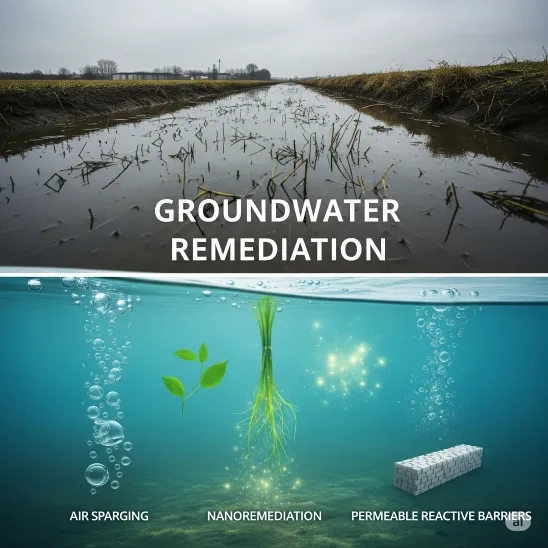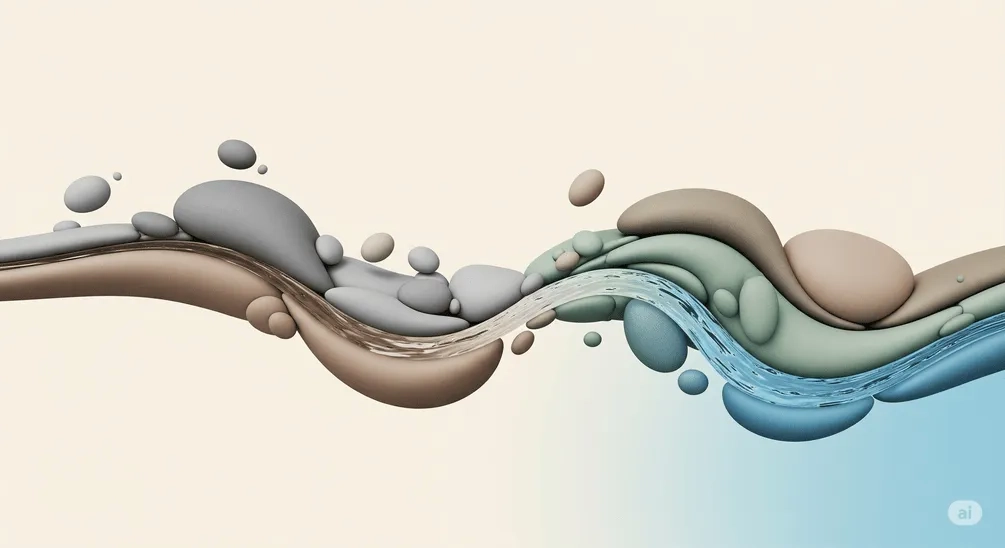
Degradation of groundwater quality is a well-known phenomenon, and it has received extensive attention since the Industrial Revolution. This degradation is due to a high concentration of groundwater contaminants and their harmful impacts on the environment. Some of the most considerable impacts are listed below (Li et al., 2021):
Groundwater contamination can negatively affect the quality of lands and forests.
Contaminated groundwater can lead to soil contamination and degradation of land quality.
Water shortages induced by contamination may become a factor causing conflicts among citizens in the future.
Chronic groundwater contamination may reduce the availability of freshwater. Sustainable economic development requires a balance between the rate of renewal of natural resources and human demand.
Groundwater contamination can impact human health, environmental quality, and socioeconomic development.
Table 1. 10 Innovative Techniques for Groundwater Contamination Remediation
10 Innovative Techniques for Groundwater Contamination Remediation
As human activities overlap with water flow paths, contamination of near-surface and underground water sources is becoming endemic. Persistent contamination of shallow and deep groundwater worldwide is caused by fertilizers and pesticides used in agriculture, solvents, chemicals used in manufacturing, mining, energy production, commercial applications, pharmaceuticals, and pathogens introduced from human waste (Lall et al., 2020).
Natural geochemical background and anthropogenic pollution threaten the quality of groundwater resources in the world (Karunanidhi et al., 2021). Therefore, various remediation techniques have been developed and used to clean contaminated water, ensuring the sustainability of groundwater resources, such as biodegradation, chemical oxidation, or adsorption reduction technologies (Zhang et al., 2017). Depending on the remedial objectives and site conditions, each treatment option has its merits and drawbacks. Various challenges, including the evolution of water treatment goals, complex characterization of underwater geophysics chemicals, an updated understanding of available technologies, contaminants in mixtures, and economics today, need to be addressed before deciding which sustainable approaches to groundwater contamination remediation are most appropriate for addressing these problems (Leeson et al., 2013).
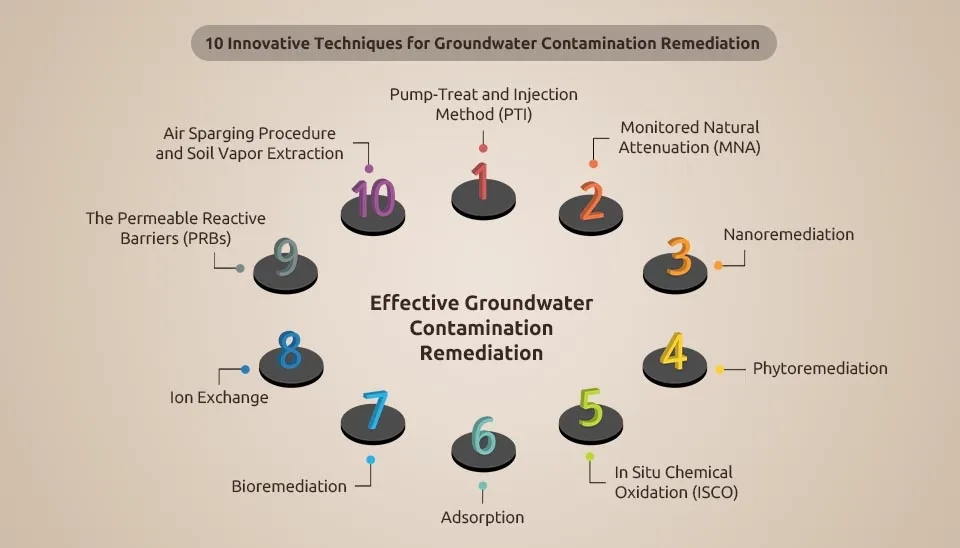
1. Contaminants of Groundwater
The quality of groundwater resources globally is threatened by the natural geochemical background and anthropogenic pollution. The main causes of groundwater contamination include human activities such as industrial discharges, waste disposal, and the excessive use of fertilizers, pesticides, and chemicals that introduce pollutants into the groundwater system (Al-Hashimi et al., 2021).
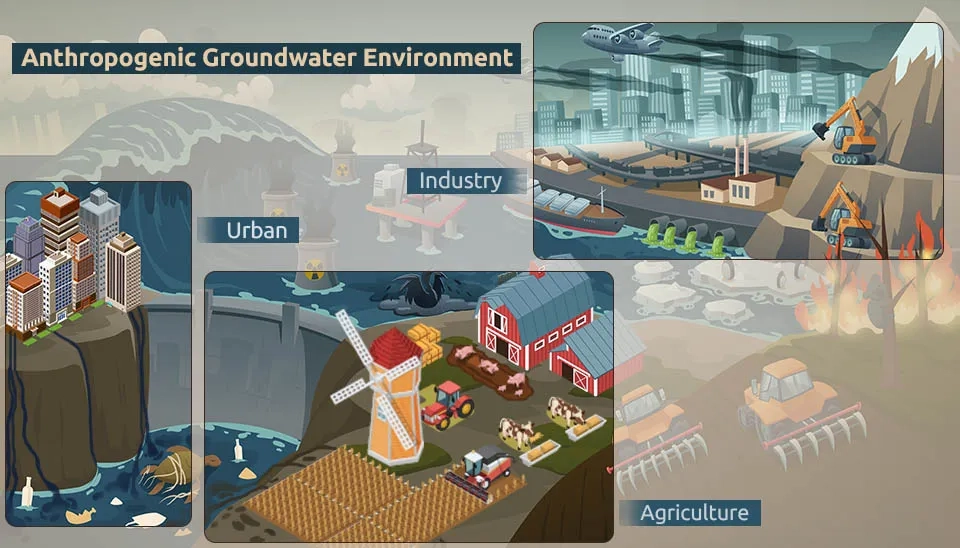
The types of contamination in groundwater are usually divided into two main categories, which are organic and inorganic contaminants that will be explained in the following paragraphs.
1.1. Organic Contaminants
A major concern for human health is the release of organic pollutants into the environment and water resources. The existence of organic contaminants in groundwater is a major environmental problem, which could affect water supply reservoirs and human health. Moreover, the ecological system may be affected (Lehosmaa et al., 2018). There are usually two sources for groundwater contamination: landfills, solid waste disposal land, sewer leakage, storage tanks leaking, agriculture, and farmyard drainage. Volatile Organic Compounds (VOCs), pesticides, plasticizers, chlorine, dioxins, pharmaceutical solvents, and antibiotics are common pollutants found in groundwater (Foster et al., 2007).
1.2. Inorganic Contaminants
The presence of inorganic contaminants is a major concern for groundwater, especially if it is used for drinking and farming. These pollutants pose health risks to the entire food chain if they appear in groundwater higher than the permitted concentration. Various organic pollutants in groundwater are antimony, arsenic, barium, cadmium, chloride, cations, iron, lead, and zinc (Sasakova et al., 2018).
2. Effective Groundwater Contamination Remediation
Scientists have been developing advanced and sophisticated techniques to clean up water from a wide range of contaminants. However, these techniques have primarily targeted the treatment of surface water sources such as rivers, lakes, and reservoirs. But nowadays, scientists and environmental researchers have become more aware of groundwater contamination and the necessity of its remediation due to its essential needs in many places (Speight, 2020; Talabi & Kayode, 2019).
2.1. Pump-Treat and Injection Method (PTI)
PTI technologies are one of the most widely used solutions for cleaning up groundwater contamination. The system relies on a network of injection and pumpage wells, with the wells at higher groundwater potentials influencing each individual pumpage well. Injection from at least one well at a higher potential is required to provide the pumping capacity of a given well. This technique for remediating groundwater contamination follows these steps: First, the clean water injected into the injection wells dilutes the contaminated aquifer water, increasing the groundwater potential at this well over that of the pumpage well. Then, the contaminants are removed from the aquifer to the pumpage wells. At last, the water is treated and ready for injection. This cycle continues to operate, resulting in the net effect of cleaning up contamination from the aquifer (Sedeghfam et al., 2017). This technology is capable of treating large volumes of contaminated water but has several drawbacks, including high costs and the spread of contamination into as well as its long operation period; it may also reverse the hydraulic gradient (Bortone et al., 2020).

2.2. Air Sparging Procedure and Soil Vapor Extraction
One of the most commonly used techniques to remediate groundwater that is contaminated by Volatile Organic Pollutants (VOCs) is air spraying and soil vapor extraction. It's thought to be effective, quick, and relatively cheap (Hu et al., 2010). This method involves the injection of pressurized air at the lowest point of the contaminated groundwater, which will clean up the groundwater by changing the state of volatile hydrocarbons to a vapor state. The contaminants are removed from the aquifer, and oxygen is provided for their biodegradation while the air is being pumped under the saturated zone (EPA, 2017). To eliminate any harmful contaminants, the cleaned air shall be treated using vacuum extraction systems. The high costs associated with working in a rough surface area and the need for many deep wells to be used for treatment are limiting the use of this method. Moreover, uneven treatment of contaminated water may occur as a result of soil heterogeneity (EPA, 2012).
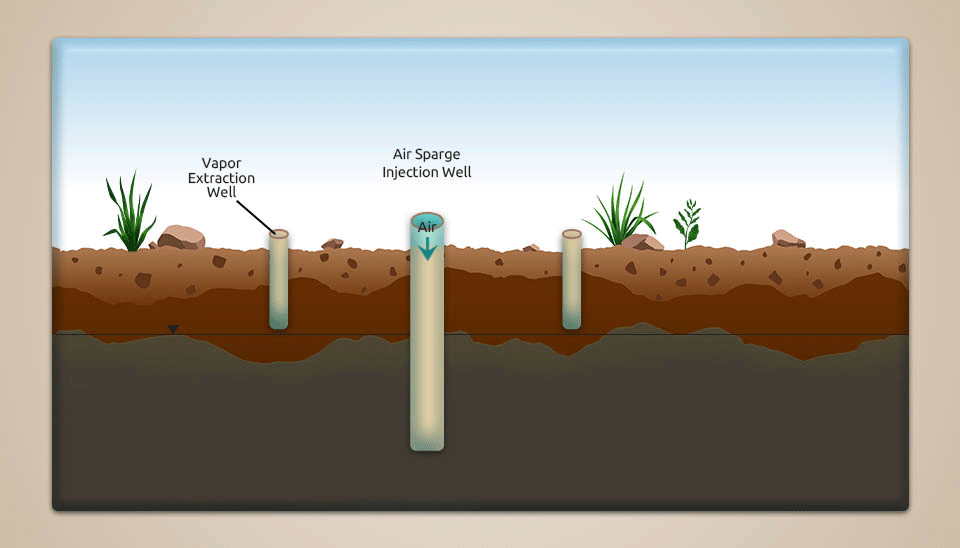
2.3. The Permeable Reactive Barriers (PRBs)
Permeability reactive barrier (PRB) technique is usually regarded as a physical method for groundwater remediation, given its design and the mechanism of removal of pollutants. However, the researchers have reported biological reactions as one of the mechanisms for pollutant removal by the PRB technique, including degradation, precipitation, and sorption (Thiruvenkatachari et al., 2008). Although alternative terms such as biological PRB, passive bio-reactive barrier, and bio-enhanced PRB have been proposed to accommodate the bioremediation or biotechnology aspect of the technique, the role of microorganisms has been reported to be mostly enhancement rather than independent biotechnology (Obiri-Nyarko et al., 2014).
Generally, various types of pollutants, such as heavy metals and chlorinated compounds, can use the PRB technique to remediate contaminated groundwater. During this technique, a permanent or semipermanent reactive barrier medium mostly composed of zero-valent iron is immersed in a groundwater-polluted trajectory. When polluted water streams into the barrier under its normal gravity line, it traps pollutants and undergoes many reactions, which result in pure drinking water flow. In theory, barriers should be reactive enough to trap pollutants, permeable enough to allow water to flow without them, passive with little energy input, inexpensive, readily available, and accessible. The efficiency of this technique is largely dependent on the type of media to be applied, with a particular focus on pollutants and biogeological conditions, local environment and health effects, mechanical stability, and costs (De Pourcq et al., 2015; Zhou et al., 2014; Garcı ́a et al., 2014).
The main disadvantages of this approach are, firstly, the PRBs installed in aquifers with low hydraulic performance or groundwater velocities require a long period of residence to treat contaminants, and thus, it may take months for them to be removed; it could lead to a substantial increase in the cost of PRB installation, which may not result in an advantage over traditional pump and treatment systems. Secondly, permeability and long-term effectiveness can be reduced by precipitates that might form in the PRB (Maitra, 2019).
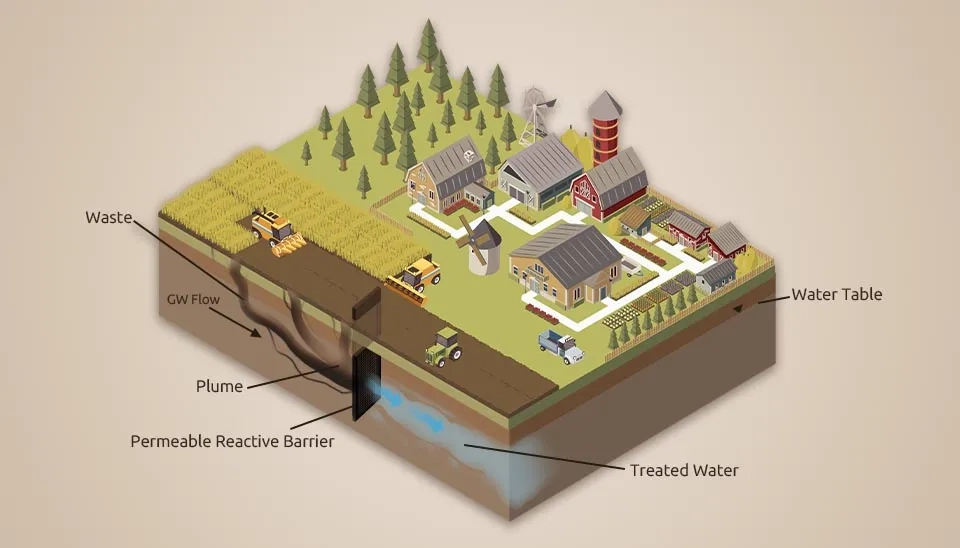
2.4. Ion Exchange
Ion exchange is a remediation technique for inorganic chemicals and dissolved metals from liquids and groundwater. The ion exchange process is that the ion (a single atom or group of atoms) is either positively charged after its loss of electrons or negatively charged after gaining an electron. When liquids loaded with pollutants pass through the ion exchange resin, contaminated substances will be exchanged by the effect of metallic ions' attraction to the resins. After being exhausted, these resins may be regrown, or they may be used as a single resin. Reversible reactions known as ion exchange phenomena occur when an identical ion on the immobilization barrier replaces the pollutant ion. The majority of ion exchangers are natural, such as zeolite, but there is also excellent synthesized ion exchanger material that can be used for specific applications in the treatment of inorganic contaminants (Interstate Technology and Regulatory Council, Perchlorate Team, 2008). The ion exchange method is applicable to remediate heavy metals and dissolved metals (chromium) from polluted liquids. Furthermore, this method is capable of treating nitrogen and ammonia pollutants, which are non-metallic (Enzei et al., 2004). The use of this method is limited by the fact that the oxidation of the soil will result in damage to the resin and reduce the effectiveness of the remediation. Another concern is that, when treated by an ion exchange method, the contamination can not be destroyed; it merely transfers to a different medium which must be discarded. If groundwater is polluted with oils or grease, this method does not work well because the exchange resins can be contaminated by these pollutants (Keller et al., 2005).

2.5. Bioremediation
Bioremediation is a metabolic process to remove or neutralize environmental pollution using biological organisms. Microscopic organisms such as fungi, algae, and bacteria are included in the “biological” organisms. Microorganisms live in a wide range of environmental conditions throughout the biosphere. They thrive in various habitats, such as soils, water, plants, animals, the deep sea, and frozen ice. Microorganisms, with their high numbers and desire for a broad range of pollutants, are ideal candidates to take care of the environment (Khan et al., 2015).
Nowadays, bioremediation techniques have been widely used and are rising at an exponential rate. Bioremediation of polluted areas has proven to be efficient and reliable, thanks to its environmentally benign characteristics. In the last two decades, advances in bioremediation techniques have been achieved with a view to successful restoration of contaminated areas for economic and environmental benefits. Bioremediation, through an integrated and comprehensive action of microorganisms, is highly involved in the degradation, eradication, immobilization, or removal of diverse chemical wastes and physically hazardous materials from the environment. In addition, this technique may involve the supply of indigenous or non-indigenous organisms to the contaminated site. There are many advantages of bioremediation compared to chemical and physical remediation, including its environmental benefits and cost-effectiveness (Anand & Padmanabhan, 2023).
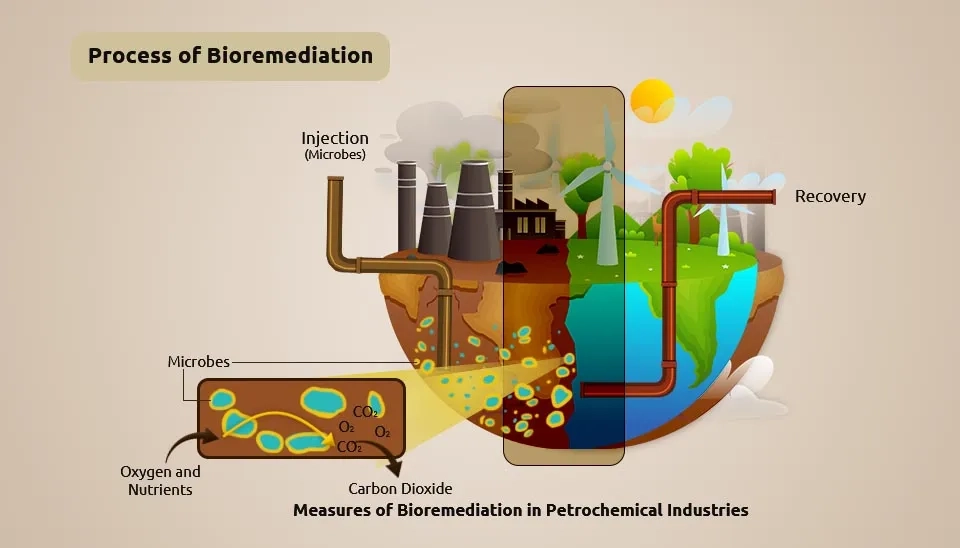
2.6. Adsorption
Absorption is an effective groundwater contamination remediation method that refers to the adsorption of atoms, ions, or molecules from a gas, dissolved solids, or liquid onto the surface (Nageeb, 2013). This process is an ex-situ method used to remove high levels of metals, such as Arsenic, and has two indicators, named adsorbent and adsorbate. The adsorbent is a material capable of adsorbing substances according to its surface area characteristics. The surface area of an adsorbent is most important in the adsorption theory. The adsorbent shall be the solid phase that provides the working adsorption area, while the substances and species adsorbed on the adsorbent shall be referred to as adsorbates. The adsorbate film is created by this process on the surface of the adsorbent (Worch, 2012). In the removal or elimination of a wide range of toxins natural, inorganic, and organic from the arrangement, adsorption is largely dependent on the porosity and movement of the adsorbent, adsorbate concentrations, liquid phase temperature, and pH. It is good to know that the low cost, ease of use, and high efficiency are the factors that attract attention to this groundwater contamination remediation technique (Song et al., 2020).
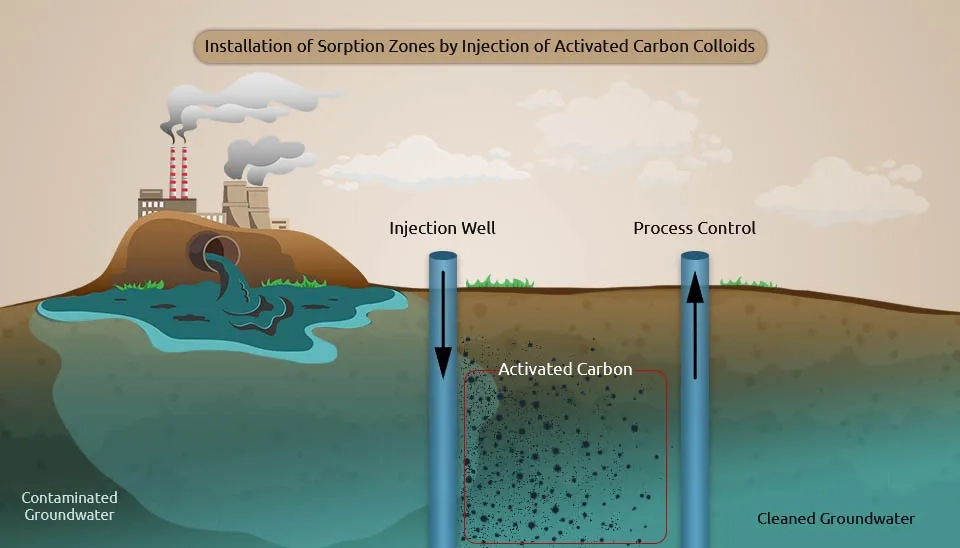
2.7. In Situ Chemical Oxidation (ISCO)
In Situ Chemical Oxidation (ISCO) is a major chemical oxidation process. In this process, the oxidants and additives are injected into the contaminated zone, where they react with the impurities. ISCO is applied only if the Natural Oxidant Demand (NOD) in the field is low; otherwise, the intrinsic inorganic or organic reductants overconsume the oxidants (Besha et al., 2018; Dangi et al., 2018). ISCO offers numerous benefits, including the ability to treat a diverse range of contaminants quickly and at a low cost. It has many advantages, such as the wide range of contaminants that ISCO is capable of handling and relatively rapid treatment, and low cost (Liu et al., 2019). The effectiveness of reducing secondary pollution is mainly determined by the oxidant's characteristics, especially its strong oxidation capacity, convenience, cost-effectiveness, and only a small amount of secondary pollution. However, oxidants have different lifetimes, mechanisms, selective oxidation for target contaminants, impacts on biodegradation, and so on. The selection of oxidants, distribution of injection wells, and duration of injections are affected by these factors. Consequently, a thorough scientific evaluation of ISCO for remediation of petroleum contamination in groundwater is necessary (Li et al., 2022).
Although ISCO is cost-effective for the degradation of many petroleum contaminants, the rebound of concentration or emission flux in contaminant plumes is commonly observed during the ISCO remediation process, which makes it difficult to achieve the expected remediation targets (O'Connor et al., 2018).
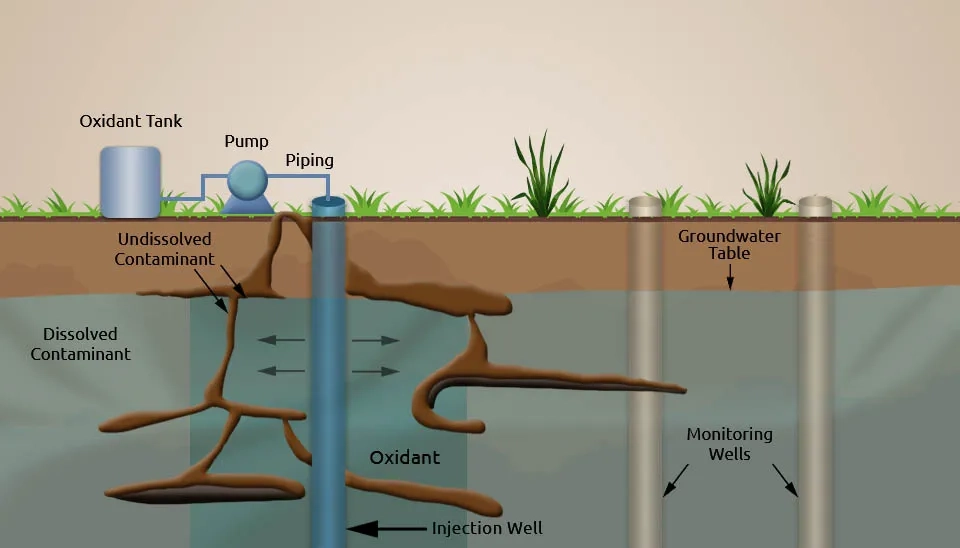
2.8. Phytoremediation
Phytoremediation is the use of plants and associated soil microbes to reduce the levels and toxic effects of contaminants in the environment (Greipsson, 2011). Not only heavy metals and radionuclides but also organic contaminants (polynuclear aromatic hydrocarbons, polychlorinated biphenyls, and pesticides) should be used. It is a novel, low-cost, efficient, environmentally friendly, field-applicable, solar-powered remediation strategy (Vithanage et al., 2012). Plants typically deal with pollutants without affecting the topsoil, thereby maintaining plant usefulness and fertility. Adding organic matter can increase soil fertility. Green plants have an excellent ability to absorb pollutants from the environment and detoxify them through various mechanisms. Phytoremediation technology is a relatively new technology, and most of the research studies have been conducted in the last two decades. It is suitable for enormous site use where other remediation methods are not cost-effective or practical. Compared to other remediation options, phytoremediation has lower installation and maintenance costs (Van Aken, 2009). Regarding cost, phytoremediation costs only 5% of the cost of other cleaning methods. Planting vegetation in contaminated soil also helps prevent erosion and metal leaching. From an economic perspective, phytoremediation of contaminated land has three objectives: (1) Risk reduction (plant stabilization) (2) Plant extraction of marketable metals such as Ni, Tl, and Au (3) Permanent land management involves using plants to extract metals, which gradually improves soil quality for future crop growth. Botanical extraction gradually improves soil quality, after which more marketable crops can be grown. In addition, high biomass-producing, fast-growing plants such as willow, poplar, and jatropha could potentially be used for both phytoremediation and energy production. Phytoremediation is also popular with the public as a “green and clean” alternative to chemical plants and bulldozers (Abhilash et al., 2012).
Techniques of phytoremediation consist of phytoextraction (or phytoaccumulation), phytofiltration, phytostabilization, phytovolatilization, and phytodegradation (Nedjimi, 2022).
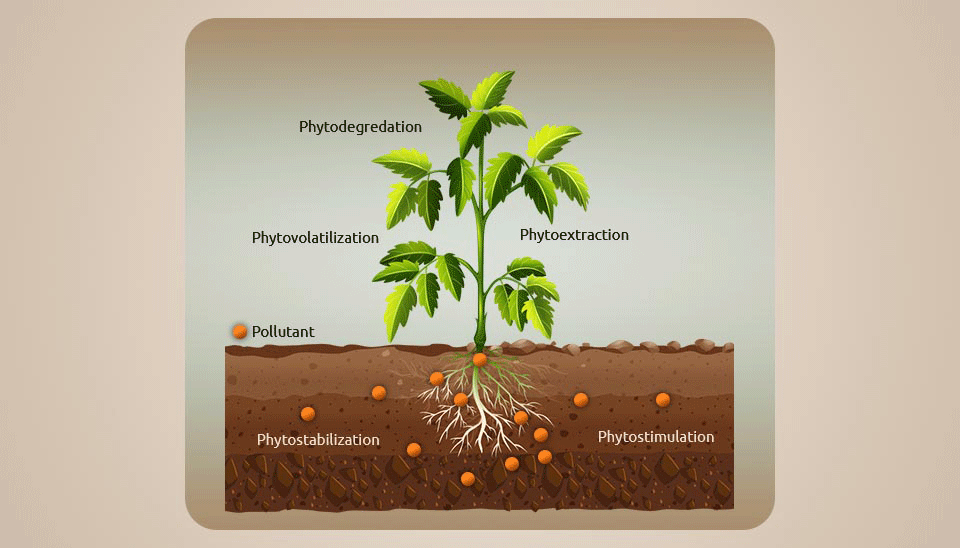
2.9. Nanoremediation
Nanotechnology has been increasingly considered in a wide range of fields over the last few years. With their enabled functions in various sectors, Nanoparticles (NPs) can display many essential and promising characteristics.
Nanoremediation technology uses NPs reactive to transform and detoxify pollutants. The main mechanisms of repair by NPs are catalysis and chemical reduction. In addition, NPs have a high surface area-to-mass ratio and a different distribution of active sites, so another removal mechanism facilitated by NPs is adsorption, which increases their adsorption capacity. Due to their innovative surface coatings and small size, many artificial NPs have excellent properties for in-situ repair applications (Chaturvedi & Dave, 2018). Moreover, NPs can diffuse and invade small subsurface spaces and remain suspended in groundwater for long periods. Compared to microparticles, NPs may be able to travel long distances and achieve greater spatial distribution. Due to their nanoscale properties, random motion or Brownian motion governs the physical motion and groundwater transport of NPs, rather than wall effects. NP migration is not controlled by gravitational settling and remains suspended in the groundwater during the remediation process, unlike microscale particles, which are strongly influenced by gravitational settling due to their density and size. NPs therefore offer a functional treatment approach that allows direct injection into the subsurface where contaminants reside (Kumar et al., 2020).
The use of nanomaterials for groundwater remediation has been extensively tested in the laboratory against several contaminants with promising results. However, nanomaterials can have positive or negative biological, environmental, social, and economic impacts and should be evaluated on a case-by-case basis (Galdames et al., 2020). Proper documentation of the risks of nanoremediation, field-scale validation of remediation results, consultation on science policy interfaces, and appropriate market development efforts are ways to increase the popularity and diffusion of nanoremediation techniques. Various nanomaterials have been investigated for groundwater contamination remediation, including metal oxides, nanoscale zeolites, enzymes, carbon nanotubes and fibers, titanium dioxide, and precious metals. ZeroValent Iron (ZVI) is generally considered to be a beneficial electron donor and highly reactive, so it is most commonly used for groundwater remediation (Pak et al., 2020, Patil et al., 2016).
In groundwater contaminated with petroleum pollutants and heavy metals, nanoremediation has proven itself to be an effective, efficient method of treatment in a very short time (Alazaiza et al., 2021).
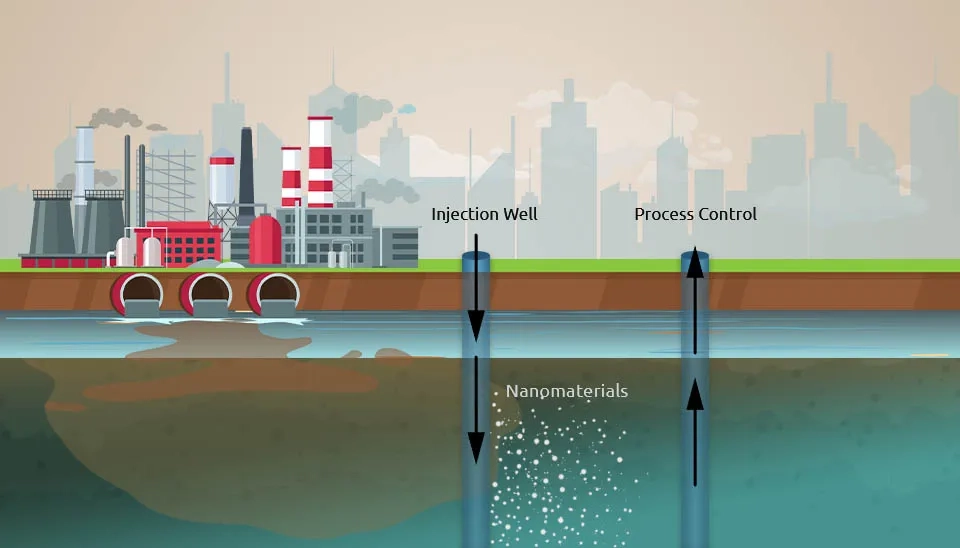
2.10. Monitored Natural Attenuation (MNA)
The use of naturally occurring physical, chemical, and biological processes acting within aquifers to reduce the mass, concentration, velocity, or toxicity of pollutants is a conceptual basis for Natural Attenuation (NA). Biodegradation, scattering, dilution, sorption, volatilization, chemical stabilization, transformation, or destruction are some of these in situ processes (Carey et al., 2000).
As a result of mixing between the plume and the background groundwater, aerobic respiration, nitrate reduction, and sulfate reduction will occur at the periphery or edge of the plume. In the core of this plume, a slower anaerobic deterioration is achieved by manganese reduction, iron reduction, and methanogenesis. Degradation processes on the fringe of the cloud are generally considered to be more important for attenuation than those at the core of the cloud. The plume length will increase until the contaminant flux from the source equals the rate of destruction from the combined fringe mixing control and the slower internal reactions (Rivett & Thorenton, 2008).
Often, the NA represents a technically valid means of managing and protecting groundwater resources and their receptors, such as supply wells or surface water, due to potential organic contamination. Where it may be used as an alternative to more active remediation technologies or in combination with them, MNA is increasingly being considered a viable site remediation strategy (Alvarez & Illman, 2006).
3. Conclusion
In recent decades, the dependency on groundwater has been increasing rapidly as a main source of fresh water for everyday human needs, while many places are suffering from contaminated groundwater due to organic and inorganic contaminants. The remediation of groundwater before use is essential to prevent the spread of contamination into neighboring environments. In the remediation of contaminated groundwater, various techniques and reactive materials have been applied, including PTI, air sparging procedures and soil vapor extraction, PRB, ion exchange, bioremediation, adsorption, ISCO, phytoremediation, nanoremediation, and MNA.
PRB, which is considered a low-cost technology, has been one of the most popular. PRB allows the treatment of several contaminants by applying multiple barriers. Additionally, there is no risk of adverse contamination when using PRB technology, since contaminants are not deposited on the surface. However, this technology may have certain limitations, such as the difficulty of detailed site surveys that are required before PRB's design; also, only contaminants that pass through the PRB could be treated to prolong their life, and in addition to limited field data on its durability, new byproduct materials are likely to be used for performance improvement of the PRB. These steps will preserve the environment by removing those unwanted substances and, in doing so, contribute to a healthier ecosystem. Lastly, to study advanced techniques for groundwater contamination remediation in the future, groundwater scientists will need to adopt and apply new technologies such as artificial intelligence, “big data” analysis, drone surveys, and molecular and stable isotope analysis technologies to develop more efficient methods.
